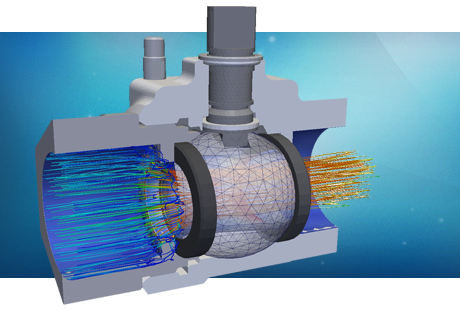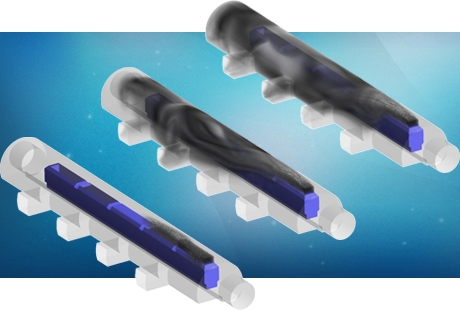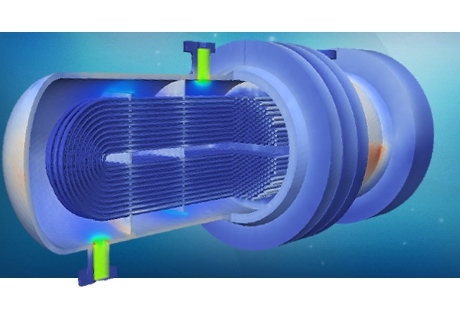Plastic and composite products

In a drive to improve performance and minimise manufacturing costs, exploring new engineering materials for use in product design is crucial. Several sectors already employ plastics (e.g. medical devices, consumer products) or composites (e.g. automotive, aerospace) extensively; others are beginning to move in this direction. PRE Technologies are experienced in the application of numerical simulation techniques for the modelling of polymer and composite materials, assisting engineers in predicting their products’ behaviour and ensuring their safety.
Simulation of plastics
Polymers are common place in many industries (consumer goods, medical equipment, packaging, domestic appliances, etc.) for their wide range of material properties, low manufacturing cost and the ability to be moulded in almost any shape required.
Thermosetting plastics are used as rigid, temperature resistant components such as polyimide circuit boards, polyurethane moulds or insulation as well as a matrix for composites (e.g. epoxy). Thermoplastics such as Nylon, PVC or HDPE are tougher materials used for gas piping, food packaging and product casings. Elastomers such as neoprene rubber are also common place as sealants and high friction materials.

In order to maximise the cost-saving benefits of using polymers, it is essential to accurately predict their mechanical response. Although plastics do not frequently encounter large loads, modelling their structural response can be complex due to the large displacements and material non linearities which are typical of these products.
Polymers exhibit a combination of elastic and viscous response to stresses. At low temperatures, elastic behaviour is dominant; elastomers such as rubbers exhibit this behaviour at room temperature. At high temperatures, viscous (i.e. fluid) behaviour is dominant. At intermediate temperatures, viscoelastic behaviour is exhibited: a non-linear combination of viscous and elastic behaviours which is typically modelled by a combination of stiffness and viscosity (i.e. springs and dampers) in networks of varying complexity (series, parallel, etc.). Viscoelastic response is time-dependent: at constant stress, creep can occur (i.e. strain increases); at constant strain, stress relaxation occurs. Beyond yield, viscoplastic models are required to capture the full material behaviour.

Some polymers, typically elastomers (e.g. rubber), have hyperelastic properties, exhibiting large deformations compared to thermoplastics or thermosets. For all of these complex, non-linear material models have been developed. The type of analyses which are required to capture all of these behaviours and optimise the design of plastic products typically involve non-linear stress analysis, explicit dynamic analyses (such as drop tests), thermal analyses, CFD analysis to optimise fluid flow patterns in, for example, sterilisation processes.
Mould filling process simulation is a complex discipline that can benefit from the use of computational models. CFD has been widely used for this purpose with the objective of determining the expected injection moulding performance for given mould void shapes and temperatures. PRE Technologies possess vast experience modelling plastic moulding processes, including injection moulding and rotomoulding.
Composites

Polymers are also used in combination with other materials forming composites. The structural arrangement of the polymers can create strong directional dependency of the material properties, resulting in a diverse range of tough, lightweight materials with broad industrial applications. Carbon fibre reinforced polymers (CFRP) are common in aerospace, automotive, marine and energy applications; glass fibre reinforced polymers are a relatively less costly alternative and have been used in civil, marine and aerospace applications amongst others.
The structured nature of fibre reinforced polymers requires anisotropic material definitions. Furthermore, these are typically arranged in laminates where individual plies are stacked, often with changing fibre orientation to address different functional strength requirements. PRE Technologies have developed the capabilities to model these materials in detail, accurately representing the structural response of composite products.

The articulate structure of composites entails a variety of potential failure modes to be captured in a structural assessment. These include fibre failure, intra-fibre (or matrix) failure (traverse or shear), damage accumulation (fatigue), buckling and delamination. Failure is quantified by a variety of criteria, some looking at macro-level phenomena (e.g. maximum stress or maximum strain criteria) and some which consider the interaction of stresses between the fibres and the matrix, such as Puck, Tsai-Wu or Tsai-Hill criteria. Typically PRE Technologies assess a combination of these criteria using specific computational techniques to capture all details of composite behaviour.
Wood
Another material which is substantially anisotropic is wood. Timber has always been used as a structural material but its complex mechanical behaviour makes precise engineering a complex task. However, by expertly defining the orthotropic material properties and effective use of modern CAD technology, accurate structural results can be achieved.
PRE Technologies have developed a set of modelling and computing tools to accurately capture different wood performances in combination with other structural construction materials, such as steel, aluminium and concrete.
For more information on other services for plastics and composites, please go to the automotive plastics, aeronautics plastics, packaging tabs or contact us here.
Our services for this sector
Plastic products
- Linear and non-linear stress and buckling analyses
- Creep and fatigue analyses for plastic components
- Mould filling studies. Transient and fluid age method
- Plastics moulding thermal studies: Rotomoulding, extrusion and injection
Composites
- Detailed modelling and analysis: Carbon fibre and glass fibre reinforced composites
- Anisotropic material properties modelling: Stress analysis
- Failure mode analysis: Fibre, intra-fibre and delamination
- Fatigue and buckling analysis for composite components
Consumer products
- Multi-body, multi-material product analysis
- Thermal and mechanical assessments
- Product life expectancy studies
- Failure prediction and forensics







